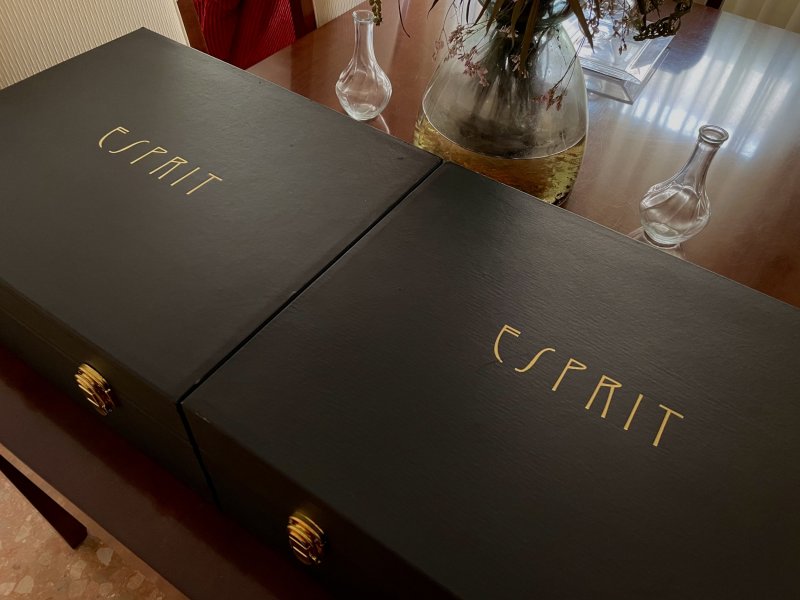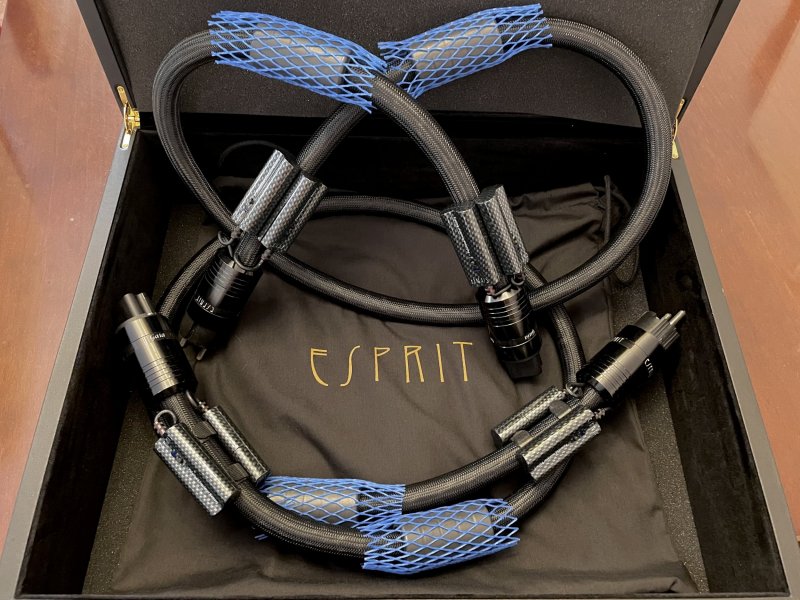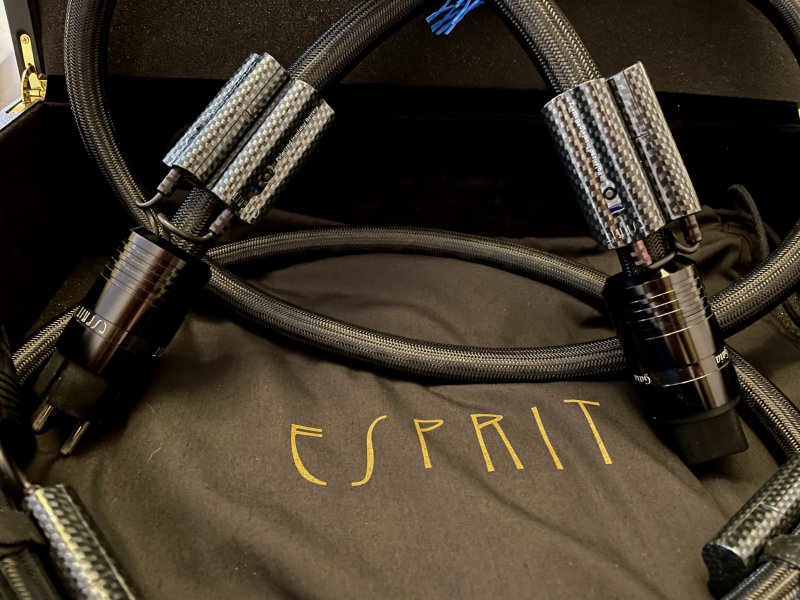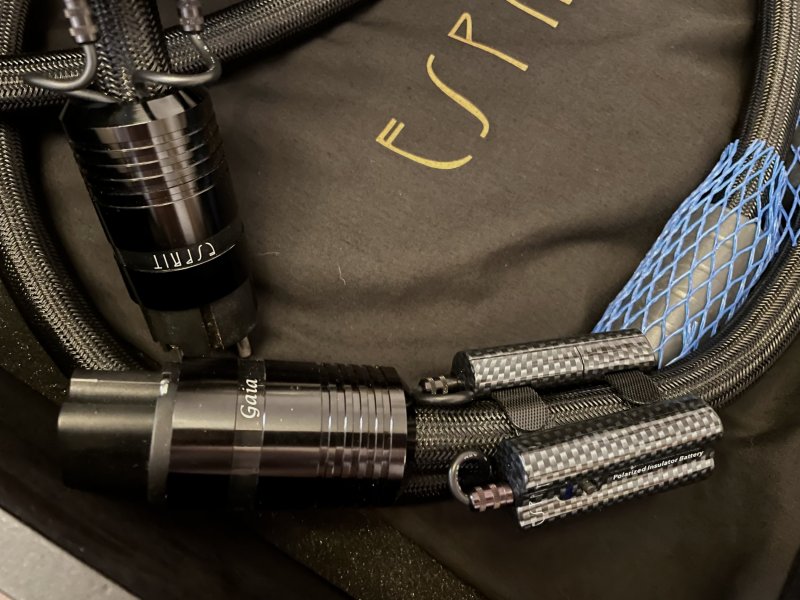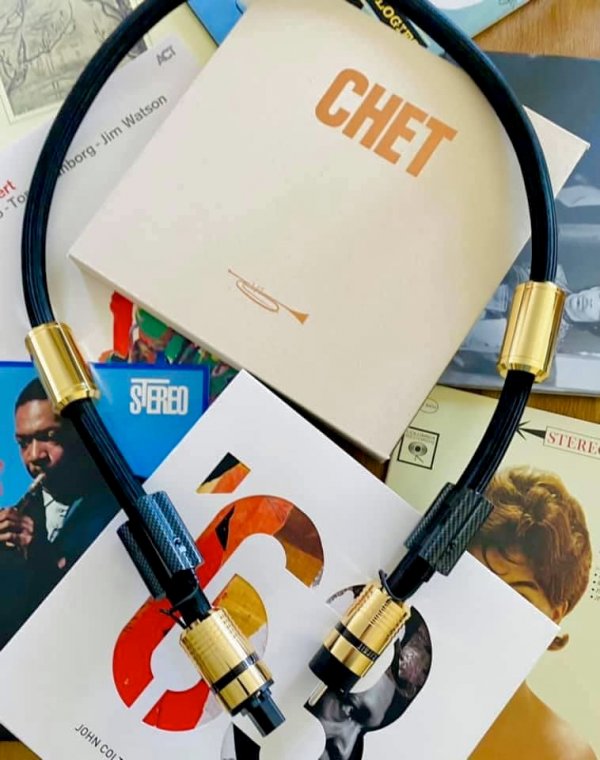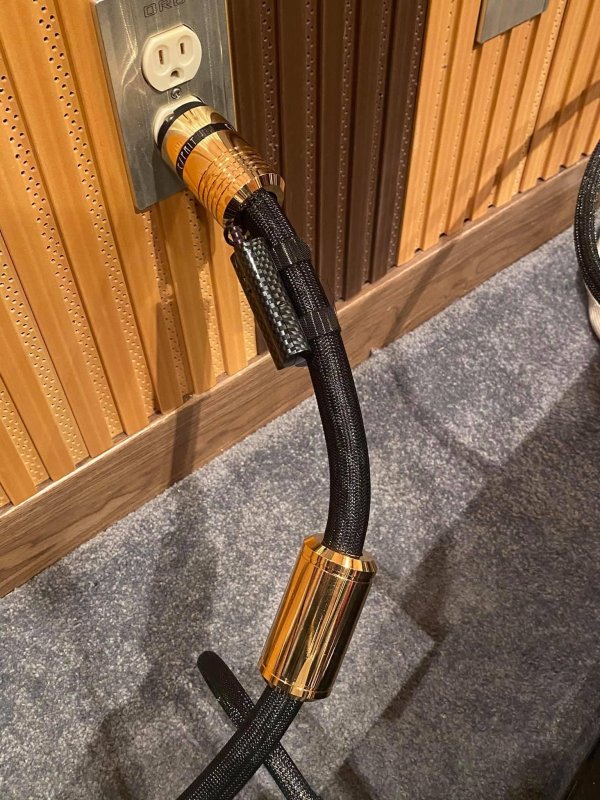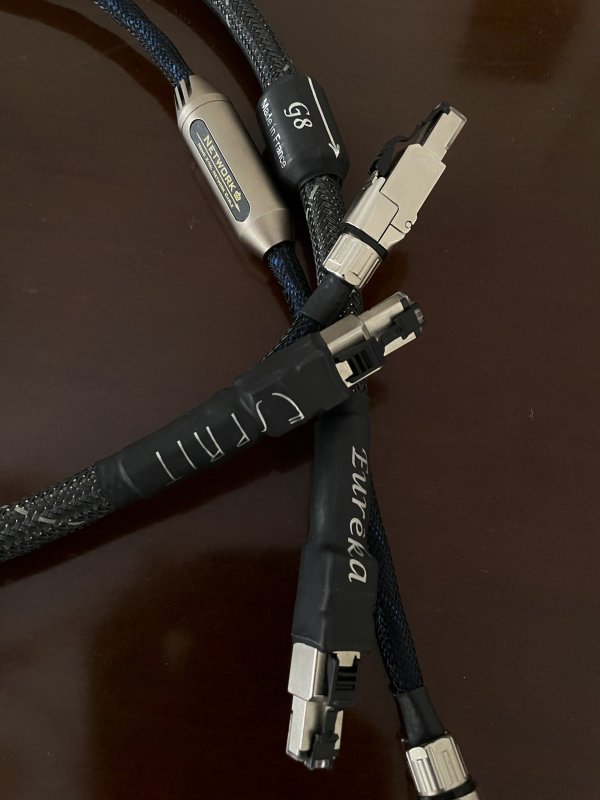Esprit Cables
- Thread starter Stereophonic
- Start date
You are using an out of date browser. It may not display this or other websites correctly.
You should upgrade or use an alternative browser.
You should upgrade or use an alternative browser.
Some technical information:
1. Structure
All Esprit cables use a symmetrical structure for conductors and an asymmetrical structure for insulators:
Symmetrical structure of materials: identical conductors for both phase (+) and neutral ( -). Compared to coaxial cables, it makes for a more dynamic, more detailed and more silent performance. It also helps tonal balance and timbre.
Asymmetrical structure of insulating materials: to avoid the build-up of an electric load inside the cable, two different insulating materials are used. Identical insulators load up the same way. Once they are loaded, it can often result in a more aggressive sound. The asymmetrical structure avoids this so that the tonal balance of your electronics and speakers are preserved.
2. Materials
There are many varied myths regarding materials that have circulated among audiophiles over the decades. The aim here is not to debunk myths, but rather to establish a few facts about conductors.
Esprit uses only OCC copper as a conductor throughout the range. With silver, OCC copper is the best conductor available on the market. One advantage of OCC copper over silver is that it is reasonably easy to find a good supplier that will guarantee consistent quality of the material. Price, of course, is another.
A robust myth is that silver cables enhance the top end of the sonic spectrum. Pure silver is in fact a very smooth sounding material, much like the sound of OCC copper. The myth behind that reputation actually comes from the fact that most ‘silver’ cables you can find on the market are in fact made of silver-plated copper.
Silver-plated copper cables are not originally manufactured for audio purposes. The plating consists of an extremely thin layer of sliver, applied with a technique called flash plating, typically 0.3 to 0.4µm. The reason for the existence of that material is purely industrial: the layer of silver is there to make the copper thread more resistant to heat when a PTFE insulation sheath is extruded over it. That super thin layer of silver is responsible for the ‘toppy’ and somewhat bright sounding character of those cables.
Esprit uses only 5N and 6N OCC copper. 5N is 99.999% pure OCC copper, and 6N is 99.9999%.
5N copper is used in Alpha, Bêta and Kappa Series. 6N copper is used on all cables from Celesta to Gaïa. We source our copper from a Japanese company that guarantees consistent, high-level quality.
As can be seen in that table, only pure solid silver is more conductive than copper, and by just a few percent. And the price of OCC silver is simply prohibitive. Esprit uses large cross section diameters of pure copper, as this eliminates the risk of noise generated by a thinner over-exploited conductor. The lower resistance of those larger conductors allows for better dynamics all across the bandwidth.
Multi-stranded structure is favoured, with 0.07mm strands on all RCA and speaker cables and 0.32mm strands on XLR interconnects. Those conductors were selected for each application according to their sonic performance after numerous listening tests.
3. Insulation Materials.
Insulation materials have their own sonic signature. For instance, stiffer dielectric materials such as High Temperature PVC tend to have a bit more bass, a slightly attenuated treble and quite a lot of punch. Softer dielectric materials, such as silicon, have a drier bass, as well as a more detailed midrange and treble.
Esprit cables use two different insulating materials: one wire is insulated with a stiff dielectric material, the other with a soft one. The result is a more balanced sonic performance, with a combination of the qualities of both.
4. Shielding.
If we were to stereotype things: fully shielded cables tend to be very silent, have a wide bandwidth and a lot of details but can be a bit dull.
On the contrary: unshielded cables are livelier, have more punch but they also generate more noise, have a narrower bandwidth and retrieve less detail.
Esprit developed what we call progressive shielding:
On the first third of the cable, there is no shielding. On the next third, there is one layer of shielding and on the last third, two layers of shielding. The result is a true combination of the qualities of shielded and unshielded cables in terms of silence, bandwidth, dynamics and details.
Esprit uses only superior, high-quality shielding material: silver on pure copper weaved strands. It’s the kind of shielding material used in military or satellite applications.
5. Connectors
As explained before, silver is the best conductor of all metals. Esprit uses proprietary connectors with a very specific technology.
Like silver plated cables, most silver-plated connectors are flash plated with an extremely thin layer of silver: 0.3 to 0.4µm. To make the silver adhere to the copper, the manufacturer generally adds a layer of nickel or chrome. And those metals are not good at conducting electricity. Gold plating is no better, and rhodium is even worse. The main quality of rhodium is that it is a self-levelling material, ensuring a nice even surface. However, its conductivity characteristics are very poor.
Silver is the way to go for connectors. Esprit have their connectors made from pure copper, then sent to a plating company where multiple layers of pure silver and pure copper are applied to the connectors. This is as close as you will get to a solid silver connector.
Where solder is used, Esprit uses only 4% silver solder.
The result is a sweet tone, zero harshness in the treble and plenty of dynamics.
6. Polarization.
The aim of polarizing a cable is to protect it from electromagnetic interference. Protecting a cable from EMI makes it more silent. More silence means bringing out more micro-dynamics and more details too, as well as more evenly distributed dynamics across the bandwidth.
There are two ways to consider an insulation material: as an insulator, or as a poor conductor. The way we polarize our cables is based on that assessment. We polarize the dielectric materials of our cables in a proprietary fashion. We can’t say much more about this here, as it forms part of the ‘secret recipe’ of Esprit! The overall idea behind it is to load the dielectric materials with an electrical signal which is not the audio signal itself.
1. Structure
All Esprit cables use a symmetrical structure for conductors and an asymmetrical structure for insulators:
Symmetrical structure of materials: identical conductors for both phase (+) and neutral ( -). Compared to coaxial cables, it makes for a more dynamic, more detailed and more silent performance. It also helps tonal balance and timbre.
Asymmetrical structure of insulating materials: to avoid the build-up of an electric load inside the cable, two different insulating materials are used. Identical insulators load up the same way. Once they are loaded, it can often result in a more aggressive sound. The asymmetrical structure avoids this so that the tonal balance of your electronics and speakers are preserved.
2. Materials
There are many varied myths regarding materials that have circulated among audiophiles over the decades. The aim here is not to debunk myths, but rather to establish a few facts about conductors.
Esprit uses only OCC copper as a conductor throughout the range. With silver, OCC copper is the best conductor available on the market. One advantage of OCC copper over silver is that it is reasonably easy to find a good supplier that will guarantee consistent quality of the material. Price, of course, is another.
A robust myth is that silver cables enhance the top end of the sonic spectrum. Pure silver is in fact a very smooth sounding material, much like the sound of OCC copper. The myth behind that reputation actually comes from the fact that most ‘silver’ cables you can find on the market are in fact made of silver-plated copper.
Silver-plated copper cables are not originally manufactured for audio purposes. The plating consists of an extremely thin layer of sliver, applied with a technique called flash plating, typically 0.3 to 0.4µm. The reason for the existence of that material is purely industrial: the layer of silver is there to make the copper thread more resistant to heat when a PTFE insulation sheath is extruded over it. That super thin layer of silver is responsible for the ‘toppy’ and somewhat bright sounding character of those cables.
Esprit uses only 5N and 6N OCC copper. 5N is 99.999% pure OCC copper, and 6N is 99.9999%.
5N copper is used in Alpha, Bêta and Kappa Series. 6N copper is used on all cables from Celesta to Gaïa. We source our copper from a Japanese company that guarantees consistent, high-level quality.
As can be seen in that table, only pure solid silver is more conductive than copper, and by just a few percent. And the price of OCC silver is simply prohibitive. Esprit uses large cross section diameters of pure copper, as this eliminates the risk of noise generated by a thinner over-exploited conductor. The lower resistance of those larger conductors allows for better dynamics all across the bandwidth.
Multi-stranded structure is favoured, with 0.07mm strands on all RCA and speaker cables and 0.32mm strands on XLR interconnects. Those conductors were selected for each application according to their sonic performance after numerous listening tests.
3. Insulation Materials.
Insulation materials have their own sonic signature. For instance, stiffer dielectric materials such as High Temperature PVC tend to have a bit more bass, a slightly attenuated treble and quite a lot of punch. Softer dielectric materials, such as silicon, have a drier bass, as well as a more detailed midrange and treble.
Esprit cables use two different insulating materials: one wire is insulated with a stiff dielectric material, the other with a soft one. The result is a more balanced sonic performance, with a combination of the qualities of both.
4. Shielding.
If we were to stereotype things: fully shielded cables tend to be very silent, have a wide bandwidth and a lot of details but can be a bit dull.
On the contrary: unshielded cables are livelier, have more punch but they also generate more noise, have a narrower bandwidth and retrieve less detail.
Esprit developed what we call progressive shielding:
On the first third of the cable, there is no shielding. On the next third, there is one layer of shielding and on the last third, two layers of shielding. The result is a true combination of the qualities of shielded and unshielded cables in terms of silence, bandwidth, dynamics and details.
Esprit uses only superior, high-quality shielding material: silver on pure copper weaved strands. It’s the kind of shielding material used in military or satellite applications.
5. Connectors
As explained before, silver is the best conductor of all metals. Esprit uses proprietary connectors with a very specific technology.
Like silver plated cables, most silver-plated connectors are flash plated with an extremely thin layer of silver: 0.3 to 0.4µm. To make the silver adhere to the copper, the manufacturer generally adds a layer of nickel or chrome. And those metals are not good at conducting electricity. Gold plating is no better, and rhodium is even worse. The main quality of rhodium is that it is a self-levelling material, ensuring a nice even surface. However, its conductivity characteristics are very poor.
Silver is the way to go for connectors. Esprit have their connectors made from pure copper, then sent to a plating company where multiple layers of pure silver and pure copper are applied to the connectors. This is as close as you will get to a solid silver connector.
Where solder is used, Esprit uses only 4% silver solder.
The result is a sweet tone, zero harshness in the treble and plenty of dynamics.
6. Polarization.
The aim of polarizing a cable is to protect it from electromagnetic interference. Protecting a cable from EMI makes it more silent. More silence means bringing out more micro-dynamics and more details too, as well as more evenly distributed dynamics across the bandwidth.
There are two ways to consider an insulation material: as an insulator, or as a poor conductor. The way we polarize our cables is based on that assessment. We polarize the dielectric materials of our cables in a proprietary fashion. We can’t say much more about this here, as it forms part of the ‘secret recipe’ of Esprit! The overall idea behind it is to load the dielectric materials with an electrical signal which is not the audio signal itself.
Oh boy!!! The Gaia !
I love my Eureka IC. Waiting for another pair and speaker cable.
It will be all Esprit Eureka here.
Haven’t listen to a more natural cable than Esprit.
I love my Eureka IC. Waiting for another pair and speaker cable.
It will be all Esprit Eureka here.
Haven’t listen to a more natural cable than Esprit.
Very nice congratulations.Hi everybody.
I haven’t seen any serious reference to this brand in WBF so here i go with my brand new cables…
ESPRIT GAIA POWER CORDS
View attachment 80985View attachment 80986View attachment 80987View attachment 80988
We have been using Esprit cables exclusively in our reference audio system - first Eureka and now Gaia.
In our opinion, Esprit designs extremely natural and refined sounding cables which will not add or subtract anything from the music.
In our opinion, Esprit designs extremely natural and refined sounding cables which will not add or subtract anything from the music.
absolutely beautiful.Esprit L’Esprit Power Cable…
Highest model specially recommended as main cable…
View attachment 81011
View attachment 81012
Could you please elaborate your system?We have been using Esprit cables exclusively in our reference audio system - first Eureka and now Gaia.
In our opinion, Esprit designs extremely natural and refined sounding cables which will not add or subtract anything from the music.
Based in my experience, Esprit PC works well in high current demanding components.
I didn’t like it in less demanding ones like sources and preamp. Too much energy…
Our own-designed reference audio system (except for the PSD-10 and cables) as follows:
Source: DNP-SR MK2
DAC: DSD-MR MK2
Amp: HAS-MR (prototype)
Speakers: Endless (prototype)
Power splitting device: PSD-10 Anniversary Edition
All cables: Esprit Gaia
We have used both Eureka and Gaia power cables on all devices, including the PRE-MR preamp, with outstanding results.
This is also the experience of our French distributor who has all of our products, as well as Esprit cables.
It is strange to me that the Esprit cables did not match with your preamp.
What interconnect cables do you use?
Source: DNP-SR MK2
DAC: DSD-MR MK2
Amp: HAS-MR (prototype)
Speakers: Endless (prototype)
Power splitting device: PSD-10 Anniversary Edition
All cables: Esprit Gaia
We have used both Eureka and Gaia power cables on all devices, including the PRE-MR preamp, with outstanding results.
This is also the experience of our French distributor who has all of our products, as well as Esprit cables.
It is strange to me that the Esprit cables did not match with your preamp.
What interconnect cables do you use?
Last edited:
Preamp TAD C600 with Siltech Empress XLR.Our own-designed reference audio system (except for the PSD-10 and cables) as follows:
Source: DNP-SR MK2
DAC: DSD-MR MK2
Amp: HAS-MR (prototype)
Speakers: Endless (prototype)
Power splitting device: PSD-10 Anniversary Edition
All cables: Esprit Gaia
We have used both Eureka and Gaia power cables on all devices, including the PRE-MR preamp, with outstanding results.
This is also the experience of our French distributor who has all of our products, as well as Esprit cables.
It is strange to me that the Esprit cables did not match with your preamp.
What interconnect cables do you use?
Based on your "too much energy" comment, my advice would be to try out Esprit XLR cables. You will not regret it.Preamp TAD C600 with Siltech Empress XLR.
Thank you.
My "too much energy" comment was about my experience with Gaia Power Cord on preamp, Dac and Server.
In my amps Gaias are simply stunning.
Gaia XLR test is in my time line, with other higher cables than Empress as well, but i think Gaia XLR could have great synergy from Pre to Amps.
Don´t in Server/Dac position.
My "too much energy" comment was about my experience with Gaia Power Cord on preamp, Dac and Server.
In my amps Gaias are simply stunning.
Gaia XLR test is in my time line, with other higher cables than Empress as well, but i think Gaia XLR could have great synergy from Pre to Amps.
Don´t in Server/Dac position.
Last edited:
It is strange that you feel Gaia will not be good for your DAC to Pre connection. What is your server and DAC? Do you use USB connection for the DAC to server connection?Thank you.
My "too much energy" comment was about my experience with Gaia Power Cord on preamp, Dac and Server.
In my amps Gaias are simply stunning.
Gaia XLR test is in my time line, with other higher cables than Empress as well, but i think Gaia XLR could have great synergy from Pre to Amps.
Don´t in Server/Dac position.
Hi Alex.It is strange that you feel Gaia will not be good for your DAC to Pre connection. What is your server and DAC? Do you use USB connection for the DAC to server connection?
Remember i’m talking about GAIA POWER CORD….
Sure, I remember you initially talked about the power cord. As mentioned, our entire audio system is wired with Gaia, this means all components are connected with Gaia power cords. Also there are Gaia RCA and XLR interconnects and 3 meters speaker cables. The sound is phenomenal, least to say. The level of naturalness, 3D detail and realism is remarkable, and all this without a hint of, glare, edginess or brightness.Hi Alex.
Remember i’m talking about GAIA POWER CORD….
The reason why I am asking what the rest of your cables and components are, is because the "too much energy" you are experiencing with the Gaia power cables, could be caused by a limitation elsewhere in your audio system. Please no offence, I am just trying to give you ideas so you can find the best possible solution. I continue to recommend wiring all of your audio system with Gaia and see/hear what happens. I hope you can get a trial period for the cables, so you can properly evaluate them.
Last edited:
Impressive look. Please tell us what you thought about it.
I use Sablon here. What cable will Eureka replace?
I use Sablon here. What cable will Eureka replace?
Hi Joao.
As you can see in the picture, Eureka Ethernet is going to replace my current Siltech Crown Ethernet.
Regards.
As you can see in the picture, Eureka Ethernet is going to replace my current Siltech Crown Ethernet.
Regards.
Similar threads
- Replies
- 18
- Views
- 1K
- Replies
- 0
- Views
- 427
- Replies
- 4
- Views
- 1K
- Replies
- 4
- Views
- 343
| Steve Williams Site Founder | Site Owner | Administrator | Ron Resnick Site Owner | Administrator | Julian (The Fixer) Website Build | Marketing Managersing |















